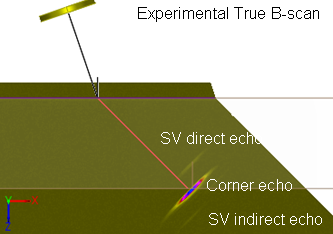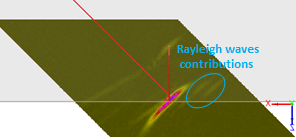Corner echoes with P mode: Generalities
Corner echoes are widely used in NDT for surface cracks detection in metal components subjected to fatigue and/or corrosion cracking. The use of simulations in order to evaluate and optimize the detectability of these cracks is of great interest and support for industries.
The following configurations contribute to the validation of CIVA predictions in the case of corner echoes associated with rectangular notches. The acoustic paths associated with corner echoes are illustrated on the figure below.
The corner echo corresponds to the double reflection, on the specimen backwall and on the notch, of an oblique incident bulk wave (P or SV wave). Mode conversion can also occur which gives rise to additional corner echoes.
The corner echoes amplitude varies with the following parameters:
- (SV and P) refraction angle in the mock-up,
- beam divergence (i.e. aperture’s probe), affecting refracted angles contained in the beam generated in the mock-up,
- probe’s central frequency relatively to the notch size and to the bandwidth,
- defect depth and location in the field profile relatively to the maximal amplitude of the field,
- angles between the specimen backwall and the flaw (tilt, skew),
- dimensions of the defect (height and extension).
According to the NDT configuration, the relative importance of these parameters may vary. Typically, the simulations validation requires variation of each influent parameters separately in order to be able to discriminate their contributions and the potential sources of discrepancy with experiments.
In the following configurations, inspections are performed with a probe generating P waves in planar, homogeneous and isotropic specimens containing vertical backwall breaking notches; tilted notches will be dealt in another study. A scanning is performed along X and Y axes. Experimental acquisitions are performed using a device consisting of a mechanical bench capable of making representations C-scan, and an ultrasound phased array acquisition system MultiX 64 controlled by the software Multi2000 V6.5.22.
Contributions associated with Rayleigh waves (circled in blue on the figure below) are not calculated with the semi-analytical model of CIVA but they are taken into account in the coupling module CIVA ATHENA 2D. Contributions associated with diffraction are calculated by CIVA but are not studied in this validation work.
In this document, the comparisons are performed on the corner echo amplitude. However, the interpretation of the results may require the analysis of A-scans, B-scans, C-scans or echodynamic curves.
The measurements are calibrated relatively to the response of a Side-Drilled Hole (SDH). Indeed, it is a reflector commonly used for calibration and which specular echoes are simulated very precisely by CIVA (see SDH response prediction with CIVA).
Continue to Synthesis of the validation cases
Back to Corner Echoes with P mode
Back to Corner Echoes





